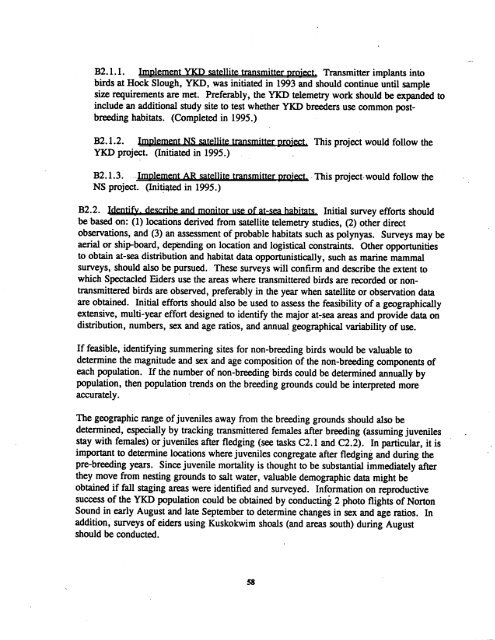A. Status of the Spectacled Eider - U.S. Fish and Wildlife Service
A. Status of the Spectacled Eider - U.S. Fish and Wildlife Service
A. Status of the Spectacled Eider - U.S. Fish and Wildlife Service
You also want an ePaper? Increase the reach of your titles
YUMPU automatically turns print PDFs into web optimized ePapers that Google loves.
B2. 1.1. Implement YKD satellite transmitter prolect. Transmitter implants into<br />
birds at Hock Slough, YKD, was initiated in 1993 <strong>and</strong> should continue until sample<br />
size requirements are met. Preferably, <strong>the</strong> YKD telemetry work should be exp<strong>and</strong>ed to<br />
include an additional study site to test whe<strong>the</strong>r YKD breeders use common postbreeding<br />
habitats. (Completed in 1995.)<br />
B2. 1.2. Implement NS satellite transmitter proiect. This project would follow <strong>the</strong><br />
YKD project. (Initiated in 1995.)<br />
B2. 1.3. implement AR satellite transmitter proiect. - This project.would follow <strong>the</strong><br />
NS project. (Initiated in 1995.)<br />
B2.2. Identify, describe <strong>and</strong> monitor use <strong>of</strong> at-sea habitats. Initial survey efforts should<br />
be based on: (1) locations derived from satellite telemetry studies, (2) o<strong>the</strong>r direct<br />
observations, <strong>and</strong> (3) an assessment <strong>of</strong> probable habitats such as polynyas. Surveys may be<br />
aerial or ship-board, depending on location <strong>and</strong> logistical constraints. O<strong>the</strong>r opportunities<br />
to obtain at-sea distribution <strong>and</strong> habitat data opportunistically, such as marine mammal<br />
surveys, should also be pursued. These surveys will confirm <strong>and</strong> describe <strong>the</strong> extent to<br />
which <strong>Spectacled</strong> <strong>Eider</strong>s use <strong>the</strong> areas where transmittered birds are recorded or nontransmittered<br />
birds are observed, preferably in <strong>the</strong> year when satellite or observation data<br />
are obtained. Initial efforts should also be used to assess <strong>the</strong> feasibility <strong>of</strong> a geographically<br />
extensive, multi-year effort designed to identify <strong>the</strong> major at-sea areas <strong>and</strong> provide data on<br />
distribution, numbers, sex <strong>and</strong> age ratios, <strong>and</strong> annual geographical variability <strong>of</strong> use.<br />
If feasible, identifying summering sites for non-breeding birds would be valuable to<br />
determine <strong>the</strong> magnitude <strong>and</strong> sex <strong>and</strong> age composition <strong>of</strong> <strong>the</strong> non-breeding components <strong>of</strong><br />
each population. If <strong>the</strong> number <strong>of</strong> non-breeding birds could be determined annually by<br />
population, <strong>the</strong>n population trends on <strong>the</strong> breeding grounds could be interpreted more<br />
accurately.<br />
The geographic range <strong>of</strong>juveniles away from <strong>the</strong> breeding grounds should also be<br />
determined, especially by tracking transmittered females after breeding (assuming juveniles<br />
stay with females) orjuveniles after fledging (see tasks C2. 1 <strong>and</strong> C2.2). In particular, it is<br />
important to determine locations where juveniles congregate after fledging <strong>and</strong> during <strong>the</strong><br />
pre-breeding years. Sincejuvenile mortality is thought to be substantial immediately after<br />
<strong>the</strong>y move from nesting grounds to salt water, valuable demographic data might be<br />
obtained if fall staging areas were identified <strong>and</strong> surveyed. Information on reproductive<br />
success <strong>of</strong> <strong>the</strong> YKD population could be obtained by conductin~ 2 photo flights <strong>of</strong>Norton<br />
Sound in early August <strong>and</strong> late September to determine changes in sex <strong>and</strong> age ratios. In<br />
addition, surveys <strong>of</strong> eiders using Kuskokwim shoals (<strong>and</strong> areas south) during August<br />
should be conducted.<br />
58

















